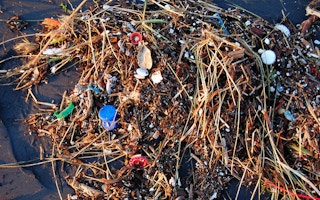By now, you’ve probably heard of the massive, floating garbage patches swirling around in each of Earth’s five major ocean basins: the North and South Atlantic, the North and South Pacific, and the Indian Ocean. Recent research has shown that mankind’s trash does not get trapped in these oceanic gyres forever, as was previously thought, but that currents flowing away from the gyres in the Pacific Ocean allow the debris to eventually wash up on the shores of North and South America.
Scientists are also becoming increasingly concerned about another place where ocean trash might be ending up: the guts (or whatever passes for a digestive tract) in marine life. Plastics and other debris that degrade very slowly can leach harmful chemicals into the ocean. Does that mean your seafood might be carrying these toxins, too?
A study published in Scientific Reports noted that marine debris is found in just about every ocean habitat, from the open ocean and the deep seas to coral reefs, estuaries, and shallow bays. Ocean trash has also been found in hundreds of marine wildlife species, including fish and bivalve species like tuna, swordfish, mussels, and oysters — the types of species you might be more familiar with as “seafood.”
Here are several ways this can affect human health: marine debris can cause physical harm such as inflammation and laceration of tissues in the gastrointestinal tract of humans who ingest it via seafood, for instance, while consuming marine debris can also increase the levels of hazardous chemicals in humans. But, as the authors of the study write, “The first step in understanding potential impacts of anthropogenic marine debris on human health is to determine whether anthropogenic marine debris is present in fish and shellfish caught and sold for human consumption.”
The study’s authors, a team of researchers from the University of California, Davis and Indonesia’s University of Hasanuddin, sampled fish sold in markets in Half Moon Bay and Princeton, California and in Makassar, Indonesia. They found that, in Indonesia, debris was present in 28 per cent of individual fish and 55 per cent of all species sampled.
The US markets had similar numbers, with debris found in 25 per cent of individual fish and 67 per cent of all species. Anthropogenic debris was also found in 33 per cent of individual shellfish the team sampled.
All of the debris recovered from fish in Indonesia was plastic, whereas anthropogenic debris recovered from fish in the USA was primarily fibers used in textiles. The researchers attribute this discrepancy in debris types to the different sources of marine debris and the particular waste management strategies employed by each country.
“
It is important to understand any hazards associated with how the ghost of waste management past may be haunting us in our own seafood.
Research scientists, University of California, Santa Barbara
Research released by University of California, Santa Barbara (UCSB) scientists in June showed just how ubiquitous fibers from textiles might be, and not just in ocean ecosystems. “[M]icrofibers are prevalent in both aquatic and terrestrial habitats, from the bottom of the Indian Ocean to farmland in the United States,” the researchers wrote on their website.
The UCSB researchers found that every time a synthetic jacket is washed, some 1.7 grams of microfibers are released from the washing machine, on average. These microfibers then travel to the local wastewater treatment plant, and from there, as much as 40 per cent of them are likely to enter into rivers, lakes, and oceans.
Once microfibers and plastics and other debris make their way into aquatic environments, they are easily consumed by marine wildlife. The authors of the Scientific Reports study said that their measurements of occurrence and quantity of marine debris in seafood are conservative, however, because the team did not count particles smaller than 0.5 millimeters in every dimension or fibers that matched the color of their lab coats and clothing.
“Still, across both locations, we found anthropogenic debris in the gut contents of greater than a quarter of individual fishes and shellfish and in the majority of species sampled — all marketed for human consumption,” they write in the study. “This result may not be surprising given both countries rank among the top 20 for mismanaged anthropogenic waste (Indonesia ranks 2nd and the USA 20th).”
The researchers added that their results “demonstrate that anthropogenic debris has infiltrated marine foodwebs to the level of humans via seafood.” And because this man-made debris is associated with “a cocktail of priority pollutants, some of which can transfer to animals upon ingestion,” there is substantial cause for concern that chemicals from ocean trash may be transferring to humans, “raising important questions regarding the bioaccumulation and biomagnification of chemicals and consequences for human health.”
While their results were cause for concern, the study authors write that further study is needed to test hypotheses about the link between plastic contamination of seafood and human health — but public health advisories might be necessary to keep seafood lovers safe.
“It is important to understand any hazards associated with how the ghost of waste management past may be haunting us in our own seafood. Future risk assessments should consider anthropogenic debris as another factor for seafood safety advisories relevant for consumers.”
This story was published with permission from Mongabay.com

















